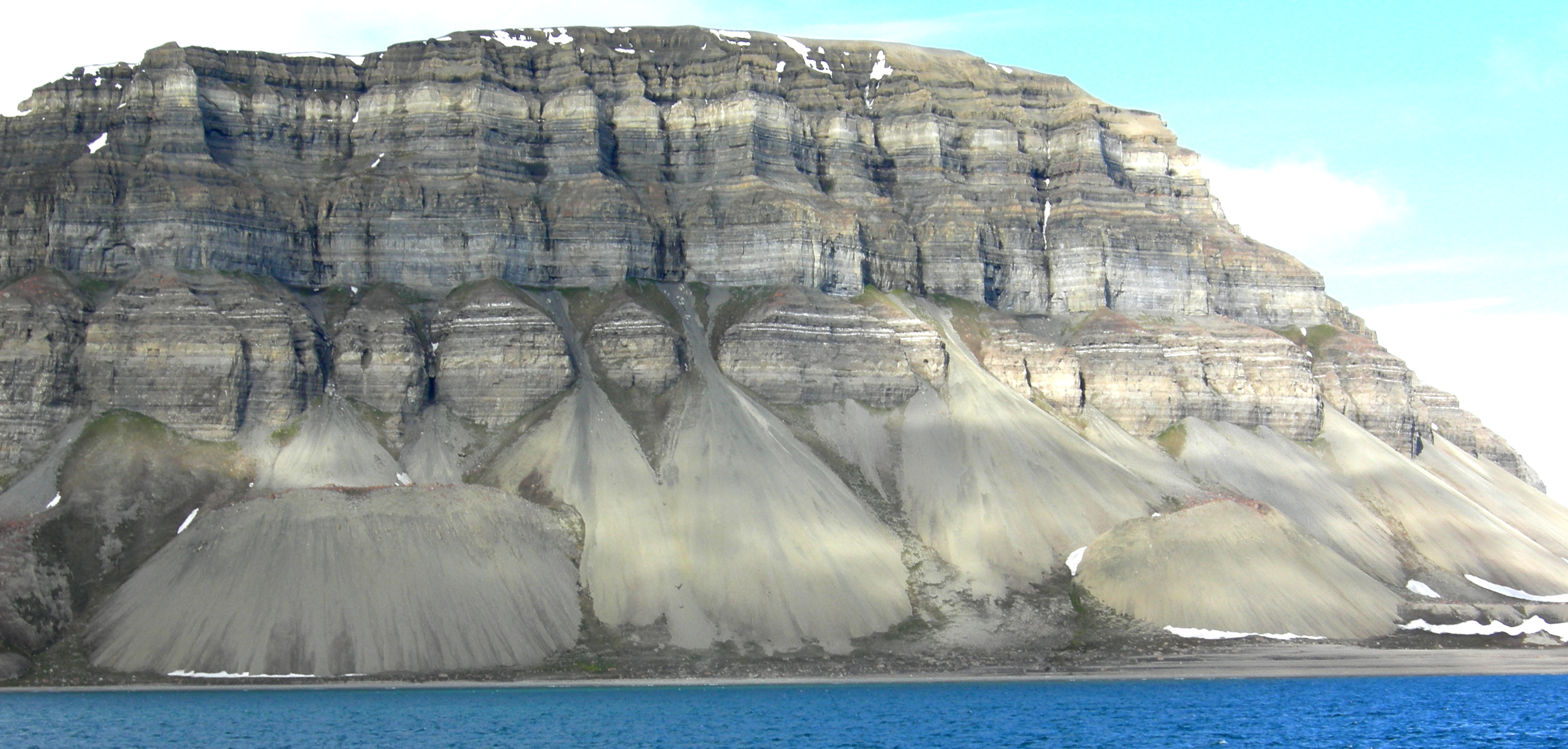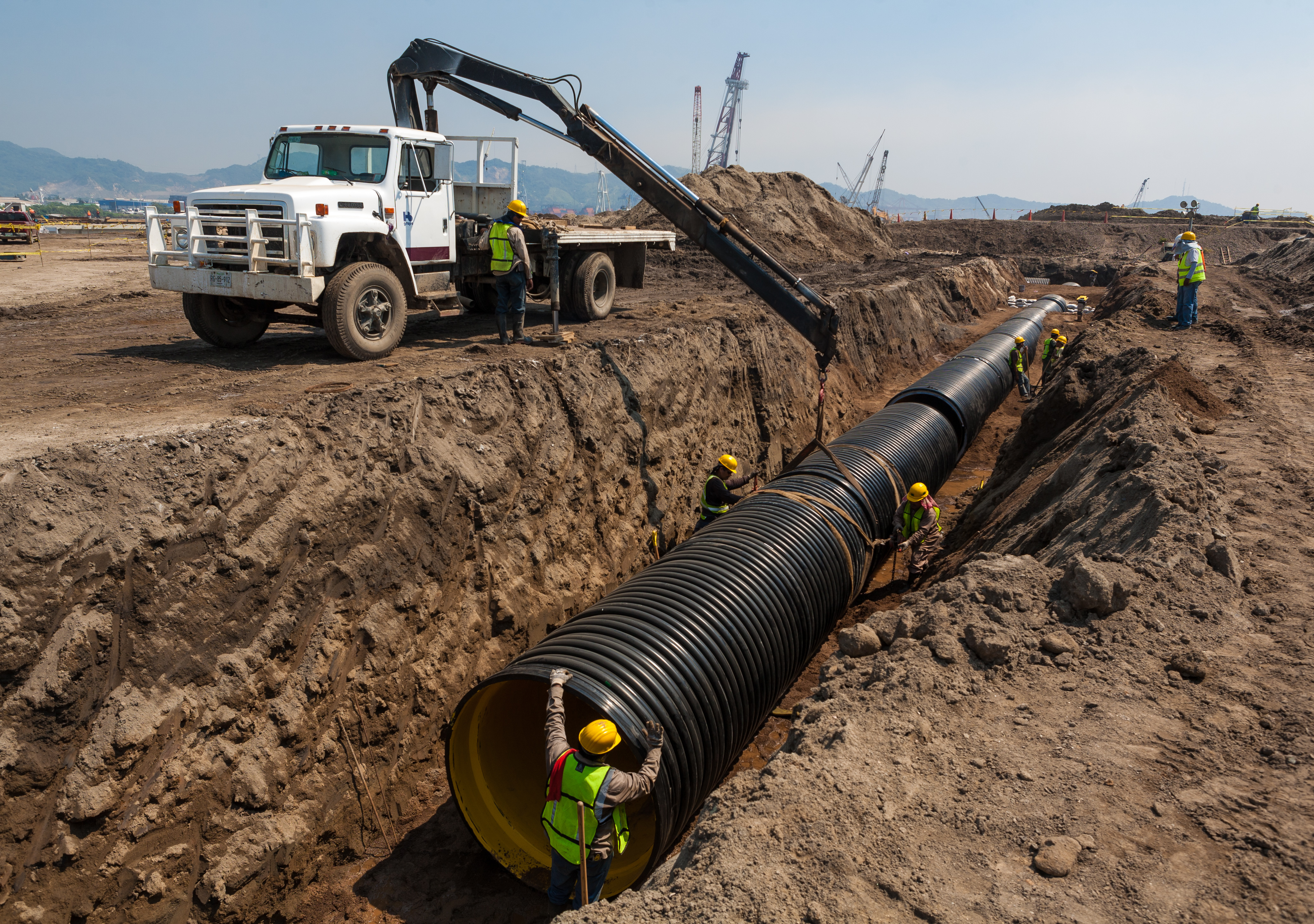|
Subsidence
Subsidence is a general term for downward vertical movement of the Earth's surface, which can be caused by both natural processes and human activities. Subsidence involves little or no horizontal movement, which distinguishes it from slope movement. Processes that lead to subsidence include dissolution of underlying carbonate rock by groundwater; gradual compaction of sediments; withdrawal of fluid lava from beneath a solidified crust of rock; mining; pumping of subsurface fluids, such as groundwater or petroleum; or warping of the Earth's crust by tectonic forces. Subsidence resulting from tectonic deformation of the crust is known as tectonic subsidence and can create accommodation for sediments to accumulate and eventually lithify into sedimentary rock. Ground subsidence is of global concern to geologists, geotechnical engineers, surveyors, engineers, urban planners, landowners, and the public in general.National Research Council, 1991. ''Mitigating losses from land ... [...More Info...] [...Related Items...] OR: [Wikipedia] [Google] [Baidu] |
Tectonic Subsidence
Tectonic subsidence is the Subsidence, sinking of the Earth's Crust (geology), crust on a large scale, relative to crustal-scale features or the geoid. The movement of Plate tectonics, crustal plates and accommodation spaces produced by Fault (geology), faulting brought about subsidence on a large scale in a variety of environments, including passive margins, aulacogens, fore-arc basins, foreland basins, intercontinental basins and pull-apart basins. Three mechanisms are common in the tectonic environments in which subsidence occurs: extension, cooling and loading. Mechanisms Extension Where the lithosphere undergoes horizontal extension at a normal fault or rift, rifting center, the crust will stretch until faulting occurs, either by a system of Fault (geology)#Dip-slip faults, normal faults (which creates horst (geology), horsts and grabens) or by a system of Fault (geology)#Listric fault, listric faults. These fault systems allow the region to stretch, while also decreasin ... [...More Info...] [...Related Items...] OR: [Wikipedia] [Google] [Baidu] |
Groundwater
Groundwater is the water present beneath Earth's surface in rock and Pore space in soil, soil pore spaces and in the fractures of stratum, rock formations. About 30 percent of all readily available fresh water in the world is groundwater. A unit of rock or an unconsolidated deposit is called an ''aquifer'' when it can yield a usable quantity of water. The depth at which soil pore spaces or fractures and voids in rock become completely saturated with water is called the ''water table''. Groundwater is Groundwater recharge, recharged from the surface; it may discharge from the surface naturally at spring (hydrosphere), springs and Seep (hydrology), seeps, and can form oasis, oases or wetlands. Groundwater is also often withdrawn for agricultural, municipal, and industrial use by constructing and operating extraction water well, wells. The study of the distribution and movement of groundwater is ''hydrogeology'', also called groundwater hydrology. Typically, groundwater is thought o ... [...More Info...] [...Related Items...] OR: [Wikipedia] [Google] [Baidu] |
Sedimentary Rock
Sedimentary rocks are types of rock (geology), rock formed by the cementation (geology), cementation of sediments—i.e. particles made of minerals (geological detritus) or organic matter (biological detritus)—that have been accumulated or deposited at Earth's surface. Sedimentation is any process that causes these particles to settle in place. Geological detritus originates from weathering and erosion of existing rocks, or from the solidification of molten lava blobs erupted by volcanoes. The geological detritus is transported to the place of deposition by water, wind, ice or Mass wasting, mass movement, which are called agents of denudation. Biological detritus is formed by bodies and parts (mainly shells) of dead aquatic organisms, as well as their fecal mass, suspended in water and slowly piling up on the floor of water bodies (marine snow). Sedimentation may also occur when dissolved minerals precipitate from aqueous solution, water solution. The sedimentary rock cover of ... [...More Info...] [...Related Items...] OR: [Wikipedia] [Google] [Baidu] |
The Crooked House
The Crooked House was a pub in South Staffordshire, England. Its name and distinctive appearance were the result of 19th-century mining subsidence which caused one side of the building to be approximately lower than the other. It was known as "Britain's wonkiest pub", and optical illusions inside the building made objects appear to roll uphill. Located in Himley in England's Black Country, the building was originally an 18th-century millhouse before it was converted into a pub in the 1830s. In July 2023, the pub closed and was sold to a quarrying and landfill business adjacent to the pub. The following month, the building was gutted in a fire and the new owners demolished it against the council's instructions. Criminal charges of Criminal damage in English law#Criminal Damage Act 1971, arson with intent to endanger life have been brought against multiple people, and the landowner has been issued with an enforcement notice which requires them to reconstruct the building. Optic ... [...More Info...] [...Related Items...] OR: [Wikipedia] [Google] [Baidu] |
Slope Movement
Mass wasting, also known as mass movement, is a general term for the movement of rock or soil down slopes under the force of gravity. It differs from other processes of erosion in that the debris transported by mass wasting is not entrained in a moving medium, such as water, wind, or ice. Types of mass wasting include creep, solifluction, rockfalls, debris flows, and landslides, each with its own characteristic features, and taking place over timescales from seconds to hundreds of years. Mass wasting occurs on both terrestrial and submarine slopes, and has been observed on Earth, Mars, Venus, Jupiter's moon Io, and on many other bodies in the Solar System. Subsidence is sometimes regarded as a form of mass wasting. A distinction is then made between mass wasting by subsidence, which involves little horizontal movement, and mass wasting by slope movement. Rapid mass wasting events, such as landslides, can be deadly and destructive. More gradual mass wasting, such as soil cre ... [...More Info...] [...Related Items...] OR: [Wikipedia] [Google] [Baidu] |
Consolidation (soil)
Soil consolidation refers to the mechanical process by which soil changes volume gradually in response to a change in pressure. This happens because soil is a three-phase material. The first phase consists of soil grains, and a combination of void (air) or other fluid (typically groundwater) comprise the second and third phases. When soil saturated with water is subjected to an increase in pressure, the high volumetric stiffness of water compared to the soil matrix means that the water initially absorbs all the change in pressure without changing volume, creating excess pore water pressure. As water diffuses away from regions of high pressure due to seepage, the soil matrix gradually takes up the pressure change and shrinks in volume. The theoretical framework of consolidation is therefore closely related to the concept of effective stress, and hydraulic conductivity. The early theoretical modern models were proposed one century ago, according to two different approaches, by ... [...More Info...] [...Related Items...] OR: [Wikipedia] [Google] [Baidu] |
River Delta
A river delta is a landform, archetypically triangular, created by the deposition of the sediments that are carried by the waters of a river, where the river merges with a body of slow-moving water or with a body of stagnant water. The creation of a river delta occurs at the '' river mouth'', where the river merges into an ocean, a sea, or an estuary, into a lake, a reservoir, or (more rarely) into another river that cannot carry away the sediment supplied by the feeding river. Etymologically, the term ''river delta'' derives from the triangular shape (Δ) of the uppercase Greek letter delta. In hydrology, the dimensions of a river delta are determined by the balance between the watershed processes that supply sediment and the watershed processes that redistribute, sequester, and export the supplied sediment into the receiving basin. River deltas are important in human civilization, as they are major agricultural production centers and population centers. They can provide ... [...More Info...] [...Related Items...] OR: [Wikipedia] [Google] [Baidu] |
Compaction (geology)
In sedimentology, compaction is the process by which a sediment progressively loses its porosity due to the effects of pressure from loading. This forms part of the process of lithification. When a layer of sediment is originally deposited, it contains an open framework of particles with the pore space being usually filled with water. As more sediment is deposited above the layer, the effect of the increased loading is to increase the particle-to-particle stresses resulting in porosity reduction primarily through a more efficient packing of the particles and to a lesser extent through elastic compression and pressure solution. The initial porosity of a sediment depends on its lithology. Mudstones start with porosities of >60%, sandstones typically ~40% and carbonates sometimes as high as 70%. Results from hydrocarbon exploration wells show clear porosity reduction trends with depth. Compaction trend estimation and decompaction process are useful for analyzing numerical basin e ... [...More Info...] [...Related Items...] OR: [Wikipedia] [Google] [Baidu] |
Lava
Lava is molten or partially molten rock (magma) that has been expelled from the interior of a terrestrial planet (such as Earth) or a Natural satellite, moon onto its surface. Lava may be erupted at a volcano or through a Fissure vent, fracture in the Crust (geology), crust, on land or underwater, usually at temperatures from . The volcanic rock resulting from subsequent cooling is often also called ''lava''. A lava flow is an outpouring of lava during an effusive eruption. (An explosive eruption, by contrast, produces a mixture of volcanic ash and other fragments called tephra, not lava flows.) The viscosity of most lava is about that of ketchup, roughly 10,000 to 100,000 times that of water. Even so, lava can flow great distances before cooling causes it to solidify, because lava exposed to air quickly develops a solid crust that insulates the remaining liquid lava, helping to keep it hot and inviscid enough to continue flowing. Etymology The word ''lava'' comes from Ital ... [...More Info...] [...Related Items...] OR: [Wikipedia] [Google] [Baidu] |
Drainage
Drainage is the natural or artificial removal of a surface's water and sub-surface water from an area with excess water. The internal drainage of most agricultural soils can prevent severe waterlogging (anaerobic conditions that harm root growth), but many soils need artificial drainage to improve production or to manage water supplies. History Early history The Indus Valley Civilization had sewerage and drainage systems. All houses in the major cities of Harappa and Mohenjo-daro had access to water and drainage facilities. Waste water was directed to covered gravity sewers, which lined the major streets. 18th and 19th century The invention of hollow-pipe drainage is credited to Sir Hugh Dalrymple, who died in 1753. Current practices Simple infrastructure such as open drains, pipes, and berms are still common. In modern times, more complex structures involving substantial earthworks and new technologies have been common as well. Geotextiles New storm water drainag ... [...More Info...] [...Related Items...] OR: [Wikipedia] [Google] [Baidu] |
Overexploitation
Overexploitation, also called overharvesting or ecological overshoot, refers to harvesting a renewable resource to the point of diminishing returns. Continued overexploitation can lead to the destruction of the resource, as it will be unable to replenish. The term applies to natural resources such as water aquifers, grazing pastures and forests, wild medicinal plants, fish stocks and other wildlife. In ecology, overexploitation describes one of the five main activities threatening global biodiversity. Ecologists use the term to describe populations that are harvested at an unsustainable rate, given their natural rates of mortality and capacities for reproduction. This can result in extinction at the population level and even extinction of whole species. In conservation biology, the term is usually used in the context of human economic activity that involves the taking of biological resources, or organisms, in larger numbers than their populations can withstand. The term i ... [...More Info...] [...Related Items...] OR: [Wikipedia] [Google] [Baidu] |
Effective Stress
Effective stress is a fundamental concept in soil mechanics and geotechnical engineering that describes the portion of total stress in a soil mass that is carried by the solid soil skeleton, rather than the pore water. It is crucial for understanding the mechanical behaviour of soils, as effective stress governs both the strength and volume change (deformation) of soil. More formally, effective stress is defined as the stress that, for any given pore pressure p, produces the same strain or strength response in a porous material (such as soil or rock) as would be observed in a dry sample where p = 0. In other words, it is the stress that controls the mechanical behaviour of a porous body regardless of pore pressure present. This concept applies broadly to granular media like sand, silt, and clay, as well as to porous materials such as rock, concrete, metal powders and biological tissues. History Karl von Terzaghi first proposed the relationship for effective stress in 1925. For ... [...More Info...] [...Related Items...] OR: [Wikipedia] [Google] [Baidu] |








